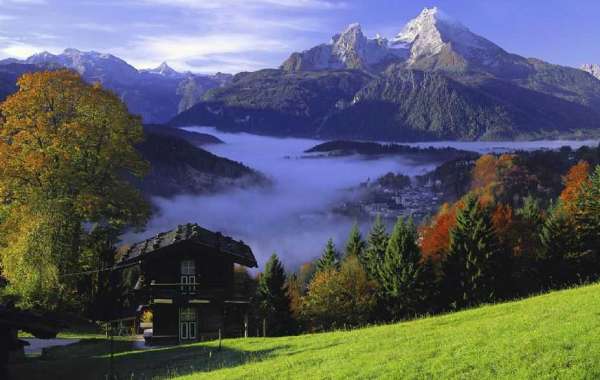Wind power parks, also known as wind farms, represent one of the most efficient and scalable solutions for generating renewable energy. As global energy demands rise and concerns about carbon emissions grow, wind power has emerged as a vital player in the transition to clean energy. These parks consist of multiple wind turbines that capture the kinetic energy of wind and convert it into electricity, providing a sustainable alternative to fossil fuels. Wind power parks are crucial to meeting the world’s energy needs while addressing the environmental challenges of climate change and resource depletion.
More Info : https://www.econmarketresearch.com/industry-report/wind-power-parks-market/
The Technology Behind Wind Power Parks
At the heart of every wind power park is the wind turbine, a complex machine designed to convert wind energy into mechanical power, which is then transformed into electrical energy. Modern turbines feature rotor blades that can range from 50 to 100 meters in length, capable of capturing large amounts of wind energy. The blades spin a shaft connected to a generator, which produces electricity. The efficiency of wind turbines depends on factors such as rotor size, wind speed, and location, with advancements in materials and design continually improving their performance. Offshore wind turbines, in particular, are larger and more powerful due to the consistent and stronger wind conditions at sea.
Site Selection and Design of Wind Power Parks
The success of a wind power park heavily depends on the selection of an optimal site. Factors such as wind patterns, topography, and environmental impact assessments are critical in determining where a wind park should be built. Ideally, wind parks are located in regions with strong, consistent winds, such as coastal areas, open plains, and mountain passes. Offshore wind parks, which are built in bodies of water, benefit from higher wind speeds and fewer obstructions, making them more efficient than onshore installations. Careful planning and design also consider grid connectivity, access to infrastructure, and the potential impact on local wildlife and communities.
Onshore vs. Offshore Wind Power Parks
Wind power parks are classified into two main types: onshore and offshore. Onshore wind parks are located on land and are generally easier and cheaper to install due to simpler logistics and maintenance access. They can be integrated into rural or agricultural landscapes, offering dual land use benefits. Offshore wind parks, however, are located in oceans, seas, or large lakes, where winds are more reliable and powerful. Offshore installations are more expensive to build and maintain, but they offer higher energy yields and less visual or noise impact on local populations. The choice between onshore and offshore depends on geographical, economic, and environmental considerations.
Environmental Impact and Sustainability of Wind Power Parks
Wind power parks provide significant environmental benefits, particularly in reducing greenhouse gas emissions and reliance on fossil fuels. Wind energy is clean, renewable, and does not produce air or water pollution, making it one of the most sustainable energy sources available. However, like all energy infrastructure, wind parks can have some environmental impacts. These may include disruption to local wildlife, especially birds and bats, and changes to landscapes that can affect ecosystems. Mitigation measures, such as proper site planning, wildlife monitoring, and technological innovations like bird-safe turbines, help minimize these effects while maximizing the environmental benefits of wind energy.
Economic and Social Benefits of Wind Power Parks
Beyond environmental advantages, wind power parks offer substantial economic and social benefits. They create jobs in manufacturing, installation, and maintenance of turbines, contributing to local economies. Wind energy projects also provide an income stream for landowners and communities through land leases and taxes. In many cases, wind power parks are developed through partnerships with local governments, ensuring that the financial benefits are distributed among the community. Additionally, as wind energy becomes more cost-effective, it helps reduce electricity prices, providing affordable energy to consumers. Wind parks also enhance energy security by reducing dependence on imported fossil fuels.
Challenges and Solutions in Wind Power Park Development
Despite the many benefits, the development of wind power parks faces several challenges. One of the primary obstacles is the variability of wind, as wind energy is intermittent and can fluctuate based on weather conditions. This can lead to inconsistent power supply unless supplemented by energy storage systems or integrated into a broader energy grid. Additionally, opposition from local communities due to concerns about noise, visual impact, and potential harm to wildlife can slow the development of new wind parks. To address these issues, developers are increasingly turning to improved turbine technology, more effective grid integration, and community engagement strategies to build support for wind projects.
Future Trends in Wind Power Parks
The future of wind power parks is set to be shaped by several emerging trends and innovations. One of the most significant developments is the rise of offshore floating wind turbines, which allow for the deployment of wind farms in deeper waters where fixed-bottom turbines cannot be installed. These floating turbines can access stronger and more consistent winds, further enhancing the efficiency of offshore wind energy. Additionally, advances in energy storage technologies, such as battery systems, will help smooth out the intermittency of wind power, making it more reliable and capable of meeting constant energy demands. Digital technologies, including AI and IoT, are also being integrated into wind park operations to optimize performance, monitor maintenance needs, and improve grid management.
Contact Us:
For inquiries, partnerships, or to learn more about our services, please contact us at [email protected] .
Phone: (+1) 812-506-4440
Mobile: +91-7875074426








